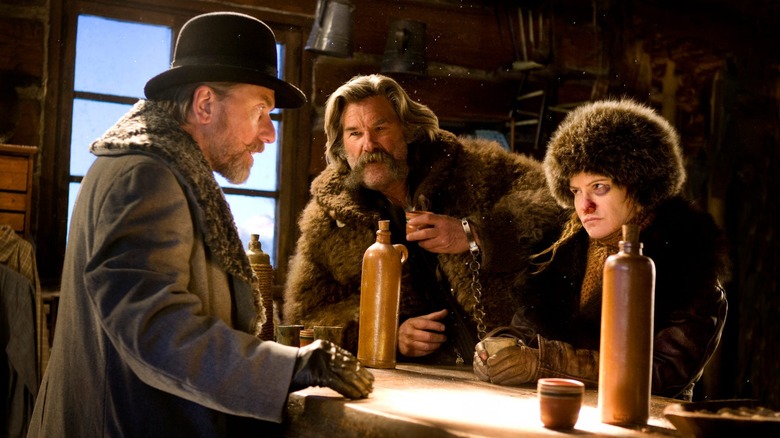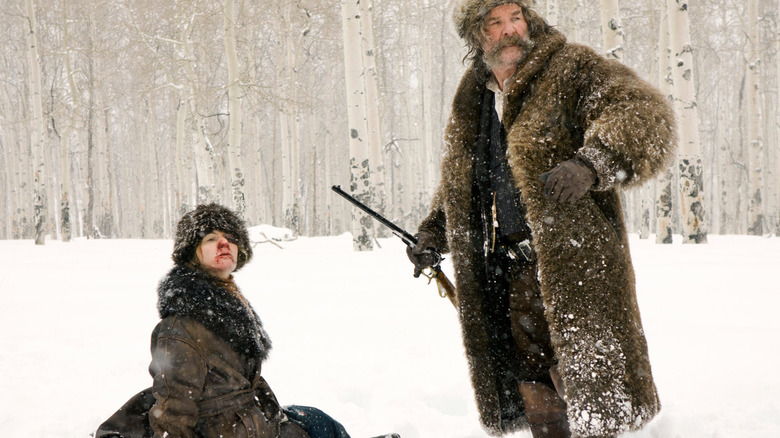The Big Gamble Quentin Tarantino Took In Making The Hateful Eight
"The Hateful Eight" is one of Quentin Tarantino's most divisive films. It also has one of the highest body counts in Tarantino's filmography. The movie feels more like a stage play in its tight focus on a group of nasty characters trapped in a cabin during a deadly blizzard. While transporting murderer Daisy Domergue (Jennifer Jason Leigh) to be lynched, bounty hunter (played by Kurt Russell) meets four other travelers — some with ulterior motives — in the warmth of Minnie's Haberdashery. Intense verbal sparring, psychological torture, and bloody shootouts ensue during their confinement. The ensemble's selfishness and deception is revolting.
Tarantino explores the racial tensions of post-Civil War America with a razor-sharp nihilism — ideas that particularly resonated with audiences in 2015, when Donald Trump's presidential campaign was in full swing. The final result of Tarantino's brazen film polarized critics and audiences, and the journey towards its release was difficult.
Filming in the Harsh Winter
Since the film was set during a raging snowstorm, Tarantino was forced to shoot exteriors under harsh conditions and had to be dependent on the unpredictability of Mother Nature. He told Entertainment Weekly:
"[Y]ou could never trust a weather report that was any more than three days in advance. So depending on what the weather was, we're either doing this or we're doing that. There was no, 'Oh, okay, we're going to start a scene and then work it to its emotional integrity until we're done with it. And then we'll do some other scene and work it to its emotional integrity.' No. It was: drop and pick up, drop and pick up, drop and pick up pretty much the entire time we were in Colorado."
This meant that the actors and filmmakers had to be on the top of their game during shooting so that they could get the take they needed within a limited time frame, unlike Tarantino's usual method. However, Tarantino noted that this chaotic way of working energized and took him out of his comfort zone. The auteur elaborated in an interview with Deadline on the importance of the weather to the story despite its instability:
"We had to juggle scenes in editing to keep things consistent, but like you said, the blizzard, snow and weather are characters. That's why we went all the way to Colorado to capture that ... When it came to that beautiful snowfall such as the opening sequence, that happened but did not occur again for 2 weeks, so often it meant we had to wait two weeks before shooting the other side of the scene. If it was foggy or cloudy, then we were in the stagecoach shooting. It wasn't about shooting with gorgeous snow on one side then fake it with phoney snow on that side, I don't operate like that. Challenging, but worth it.
The cold, volatile environment is the perfect backdrop for his vile characters' squabbling, and serves as a metaphor for their chilling cruelty.
Shooting in 70mm
Another challenge in the creation of "The Hateful Eight" was shooting in 65mm with Ultra Panavision 70 lenses that had not been used since the film "Khartoum" in 1966. This was part of Tarantino's ongoing commitment to keep shooting on film alive. Tarantino's award-winning cinematographer Robert Richardson noted that type of celluloid and the widest aspect ratio of 2.76:1 "provides such unparalleled scope, resolution and beauty that everyone should be using it" (via IndieWire). "The Hateful Eight" marked the first anamorphic 70mm theatrical release in nearly half a century.
Although Tarantino was confident that he could revitalize this style of shooting after the testing the cameras, he was worried about the freezing cold's effect on them. He told Entertainment Weekly:
I just had to assume that there would be times that the lenses would freeze, or that the big camera would freeze. We're dealing with a really tricky technical process and we're doing it in a very untricky way, being open to the elements the way we were. And I'd already had a bad experience with that to some degree or another at least on one important day on Django when we were shooting in the snow. Even the guns didn't work. And that happened to be the day we were doing Django's fast draw. So literally in between takes, you got a hair dryer on the lenses and a hair dryer on the guns to make sure that they were warm enough.
Tarantino thanked Gregor Tavenner, the AC on "The Hateful Eight," who did everything he could to secure the cameras so that a similar incident would never happen.
A Roadshow Style Release
Quentin Tarantino's "The Hateful Eight" was released roadshow style in a few theatres that could screen films on 70mm. A roadshow release is a form of theatrical exhibition that was popular during the era of the spaghetti westerns that Tarantino so lovingly homages. It involves showing a film to a limited number of theatres for a certain time period before wide release. Often this version of the film includes extra footage.
"The Hateful Eight" roadshow boasted an exciting, theatrical event style atmosphere that included an overture, intermission, and extended scenes. The roadshow version runs for three hours and two minutes and has alternate takes of certain scenes because Tarantino felt some of the 70mm footage would not work on smaller screens.
Tarantino took a gamble in making "The Hateful Eight" by using an antiquated method of filming and withstanding a turbulent winter. In doing so, though, he successfully used the expansive landscapes of the frosty snow to emphasize the empty, cold nature of the characters and juxtapose their uncomfortable imprisonment indoors. It's a risk that paid off, as the brutal western is one of Tarantino's most compelling works.



